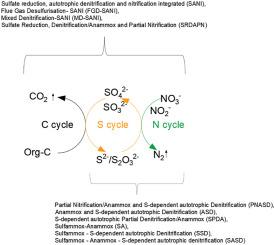Journal of Cleaner Production ( IF 9.7 ) Pub Date : 2022-08-13 , DOI: 10.1016/j.jclepro.2022.133495 Dominika Grubba , Zhixuan Yin , Joanna Majtacz , Hussein Ezzi Al-Hazmi , Jacek Mąkinia

|
In wastewater treatment systems, sulfur (S) removal processes are generally based on heterotrophic sulfate (SO42−) reduction by sulfate reducing bacteria and S-dependent autotrophic denitrification by sulfur oxidizing bacteria. A combination of either two cycles (N and S) or three cycles (N, S and C) appears to be a viable approach to sustainable wastewater treatment, resulting in energy savings and reduction of sludge production. This review shows how the S cycle can be coupled with the other cycles in single systems for efficient N and S removal. Operating conditions, advantages, limitations and challenges of such systems are described. S removal processes are generally based on heterotrophic sulfate (SO42−) reduction by sulfate reducing bacteria and S-dependent autotrophic denitrification by sulfur oxidizing bacteria. In terms of pH and temperature, the optimum conditions are determined by the narrowest ranges for heterotrophic SO42− reduction (pH of 7–7.6, T = 28–30 °C). The combined processes allow for almost complete N removal, while the efficiency of SO42− removal can reach up to 75%. Among all the processes linking the N, S and C cycles, SANI (sulfate reduction, autotrophic denitrification and nitrification integrated) has been best recognized. Recently, the growing attention has been paid to the novel sulfammox process, which involves SO42− dependent, anaerobic ammonia oxidizing bacteria. Numerous systems have been developed to combine SO42− reduction, S-dependent autotrophic denitrification and partial nitritation/anammox processes. The coexistence of several bacterial groups and their competition for the substrates is thus a key issue to be considered. Specific inhibitors for each bacterial group also need to be recognized before full-scale implementations. Moreover, modeling the transformations of S compounds has been incorporated with respect to all the processes responsible for those transformations.
中文翻译:

将硫循环纳入可持续脱氮系统 - 综述
在废水处理系统中,硫 (S) 去除过程通常基于硫酸盐还原细菌的异养硫酸盐 (SO 4 2- ) 还原和硫氧化细菌的 S 依赖性自养反硝化。两个循环(N 和 S)或三个循环(N、S 和 C)的组合似乎是可持续废水处理的可行方法,从而节省能源并减少污泥产生。这篇综述展示了 S 循环如何与单个系统中的其他循环相结合,以实现有效的 N 和 S 去除。描述了此类系统的操作条件、优点、局限性和挑战。S 去除工艺通常基于异养硫酸盐(SO 4 2-) 硫酸盐还原菌的还原作用和硫氧化菌的 S 依赖性自养反硝化作用。在 pH 和温度方面,最佳条件由异养 SO 4 2-还原的最窄范围确定(pH 为 7–7.6,T = 28–30 °C)。联合工艺几乎可以完全去除 N,而 SO 4 2-去除效率可高达 75%。在连接 N、S 和 C 循环的所有过程中,SANI(硫酸盐还原、自养反硝化和硝化一体化)得到了最好的认可。最近,新的磺胺氨法工艺受到越来越多的关注,该工艺涉及 SO 4 2−依赖性,厌氧氨氧化细菌。已经开发了许多系统来结合 SO 4 2-还原、S 依赖性自养反硝化和部分亚硝化/厌氧氨氧化过程。因此,几个细菌群的共存及其对底物的竞争是需要考虑的关键问题。在全面实施之前,还需要识别每个细菌群的特定抑制剂。此外,S 化合物的转化建模已纳入所有负责这些转化的过程。











































 京公网安备 11010802027423号
京公网安备 11010802027423号